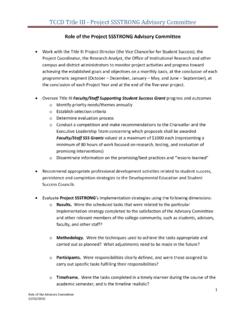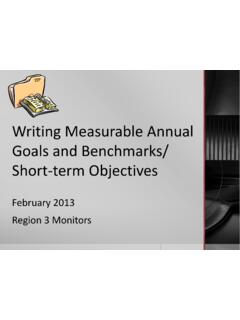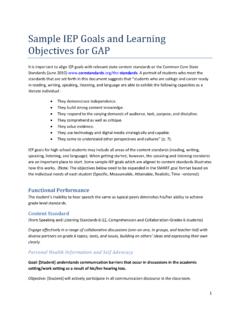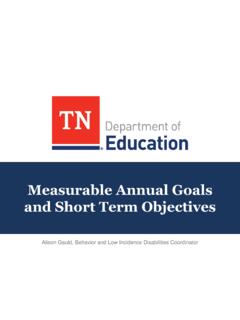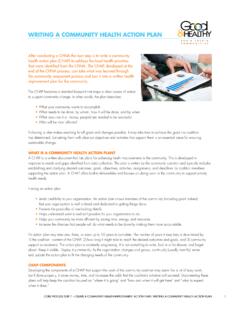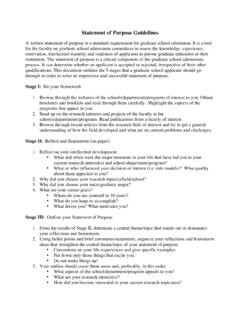Transcription of Writing Outcomes/Objectives: A Guide
1 Writing Outcomes/ objectives : A Guide Measurable objectives : This Guide is intended to assist you in Writing measurable objectives for your Institutional Effectiveness Plan (IEP). Measurable objectives are specific statements expressing the desired qualities of key services; and the expected results of the services/experience. objectives should state: Who is involved: The people whose behaviors, knowledge and/or skills are to be changed as a result of the program. What are the desired outcomes: The intended behavior, knowledge and/or skill changes that should result from the program or activities. How progress is measured: What tool or device (surveys, tests, data from other sources) will be used to measure the expected changes. Ensure that your department has the resources/capacity (time, staff, funding, etc.) to perform the measurement. Proficiency level: Identify the criteria for success.
2 When will the outcome occur: Identify the time-frame for success. Example: By August 2014, IEP noncompliance will decrease by 90% amongst planning unit managers (PUMs) at TCCD as captured by IRPE's Quality Audit. Who: PUMs How measured: As captured on an IRPE's Quality Audit What: Decrease of IEP noncompliance Proficiency level: To 90%. When: By August 2014. Measurable objectives can relate to student learning outcomes (SLO) or operational outcomes (OO): Faculty (SLO) Staff (OO). What is the outcome? What is the outcome? Change in achievement Knowledge Change in behavior Skill Change in attitude Attitude Pedagogy Achievement/production How is it measured? How is it measured? Assessment Observation Incidence of behavior Logs Student log Assessment Survey Surveys Output TCCD Office of Institutional Effectiveness and Compliance (IEC). Page 1. Use concrete terms that can form the basis of specific outcomes/ objectives .
3 The following concrete terms should be CONSIDERED when Writing outcomes to: Produce Apply Predict Identify Employ Evaluate Increase Illustrate Defend Integrate Use Assess Reduce Interpret Distinguish Improve Categorize Diagram Solve Formulate Report Relate Restate Recall Prepare Review List Arrange Classify Enhance Construct Translate Recognize Create Discriminate General terms such as those listed below are inadequate, as they are open to many interpretations and are not quantifiable. Therefore, AVOID the following general terms when Writing objectives , to: Know Organize Understand Really understand Fully appreciate Internalize Grasp the significance OF. Have an awareness OF. Objective Writing Tips: Step 1: Determine the following: What is the object of your study/work as a planning unit? What is the purpose of your study/work as a planning unit? What ideas/thoughts are representative of your discipline/profession?
4 What words are associated with specific knowledge/skills in your discipline/profession? TCCD Office of Institutional Effectiveness and Compliance (IEC). Page 2. Step 2: Most objectives need to have the following three components: A measurable verb (also known as performance). The important conditions (if any) under which the performance is to occur and The criterion for acceptable performance objectives can be written in a manner that implicitly or explicitly outlines important conditions/criterion. Example 1: An objective might be stated as follows: -The department will be able to efficiently process ad hoc data requests. A more appropriate objective can be explicitly expressed to meet criterion requirements as follows: -The department will correctly (criterion) process ad hoc data requests within 2 weeks (criterion). Example 2: An instructor might write an objective with a general (implicit) statement such as: -The learner will be able to prepare appropriate new patient workups.
5 However, this objective may be too general to be instructional to the student. To make it explicit so that the students know what they are expected to learn, the objective could be written as follows: -The learner will be able to prepare legible, comprehensive and focused new patient workups that include the following: o Present illness organized chronologically without repetition, omission or extraneous information;. o A comprehensive physical examination with details pertinent to the patient's problem;. o A succinct and, where appropriate, unified list of all problems identified in the history and physical examination;. o A differential diagnosis for each problem (appropriate to level of training) and o A diagnosis/treatment plan for each problem (appropriate to level of training. SLO Examples: Three examples of SLOs that are general and not easily measurable are presented below, followed by examples that make these outcomes specific and measurable.)
6 SLO Example 1: General: The learner will be able to orally present a new patient's case More Specific: The learner will be able to: (a) orally present a new patient's case in a logical manner, (b). chronologically develop the present illness and (c) summarize the pertinent positive and negative findings, as well as the differential diagnosis and plans for further testing and treatment. TCCD Office of Institutional Effectiveness and Compliance (IEC). Page 3. SLO Example 2: General: The learner will be able to prepare appropriate new patient workups. More Specific: The learner will be able to prepare legible, comprehensive, and focused new patient workups that include the following features: o Present illness organized chronologically, without repetition, omission or extraneous information. o A comprehensive physical examination with details pertinent to the patient's problem.
7 O A succinct and, where appropriate, unified list of all problems identified in the history and physical examination. SLO Example 3: General: The learner will be able to retrieve medical information using a computer. More Specific: The learner will be able to: (a) retrieve information, demonstrating the ability to perform database searches using logical operators, in a manner that reflects understanding of medical language, terminology and the relationship among medical terms and concepts; (b) refine search strategies to improve relevance and completeness of retrieved items; (c) use standard bibliographic applications to download citations from a search and organize them into a personal database and Identify and (d) identify and acquire full-text electronic documents available from the Internet. OO Examples The following are three examples of operational outcomes that are general and not easily measurable followed by an effort to make these outcomes specific and measurable.
8 OO Example 1: General: The Admission's office will be able to process more student applications. More Specific: The Admissions office will be able to systematically process more student applications by: (a). categorizing the applications by majors, (b) documenting rejected applications, and (c) advising applicants on incomplete applications. TCCD Office of Institutional Effectiveness and Compliance (IEC). Page 4. OO Example 2: General: The IRPE office will be able to respond to ad hoc data requests. More Specific: The IRPE office will be able to: (a) efficiently respond to data requests by ensuring all timelines are met, (b) proof all data prior to sending to the data requestor and (c) send satisfaction surveys to data requestors after the requestors have had time to review the provided data. OO Example 3: General: The human resource department will expedite new hire process.
9 More Specific: The human resource department will be able to: (a) reduce hire time from 8 to 4 weeks, (b) process rejection letters 2 days after interviews and (c) complete background checks in 24 hours. TCCD Office of Institutional Effectiveness and Compliance (IEC). Page 5. Outcomes/ objectives Worksheet Directions: Write your goal and objectives for each goal in the space provide below. Include: (a) who is involved, (b) what the desired outcomes are, (c) how progress will be measured, (d) when the outcome will occur and (e) the proficiency level. Then, put the pieces together into a sentence. Finally, use the provided checklist to ensure that the objectives contain all necessary components. Use a new worksheet for each goal. Goa1 l: _____. _____. Objective 1: Who: _____ What: _____. How: _____When:_____. Proficiency level:_____. Written objective:_____. _____. Objective 2: Who: _____ What: _____.
10 How: _____When:_____. Proficiency level:_____. Written objective:_____. _____. TCCD Office of Institutional Effectiveness and Compliance (IEC). Page 6. objectives Checklist objectives contain all elements: Who What How When Proficiency Level Redundancy has been eliminated objectives relate to needs assessment findings objectives can really be measured Capacity to perform measurement? Instrument or data source has been identified TCCD Office of Institutional Effectiveness and Compliance (IEC). Page 7. Sample Education Performance Measures Number and percentage of programs closing Number and percentage of minority students achievement gaps between all students and taking advanced courses compared to state subgroup students meeting or exceeding state average, disaggregated by subgroup and course performance standards, disaggregated by type subgroup Number and percentage of modified diplomas Number and percentage of courses that maintain given to special education students a 92% average student attendance rate, disaggregated by grade level and Title I status Number of suspension, expulsion and truancy Number of students on time to degree as incidents by type, and number and percentage of measured by the number of graduates who students involved.

